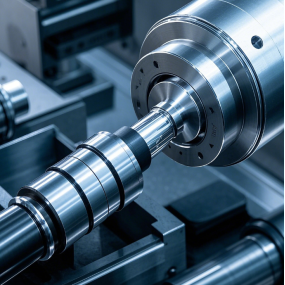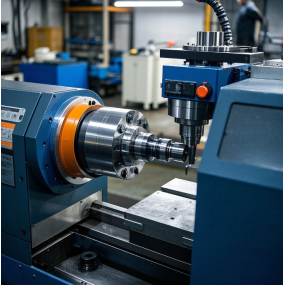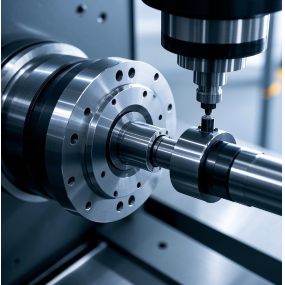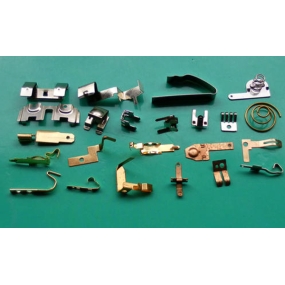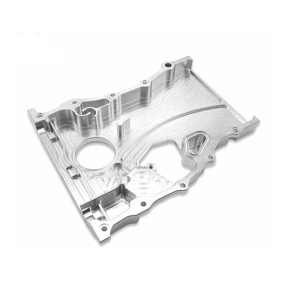In EDM, the tool electrode and the workpiece are respectively connected to the two poles of the pulse power supply, and immersed in the working liquid, or the working liquid is filled into the discharge gap. The tool electrode is fed to the workpiece through the gap automatic control system. When the gap between the two electrodes reaches a certain distance, the pulse voltage applied on the two electrodes will break through the working liquid and produce spark discharge.
A large amount of heat energy is instantaneously concentrated in the fine channel of the discharge, and the temperature can reach more than 10,000 C, and the pressure also changes sharply, so that the local trace metal material on the working surface immediately melts, vaporizes, and explodes into the working liquid, rapidly condenses, forming solid metal particles, which are carried away by the working liquid. At this time, a tiny pit mark is left on the surface of the workpiece, and the discharge is briefly stopped, and the working liquid between the two electrodes is restored to an insulating state.
Then, the next pulse voltage breaks down at another point where the two electrodes are relatively close, generating a spark discharge, and repeating the above process. In this way, although the amount of metal etched by each pulse discharge is very small, due to the thousands of pulses per second, more metal can be etched away, with a certain productivity.
 Under the condition of maintaining a constant discharge gap between the tool electrode and the workpiece, while etching the workpiece metal, the tool electrode is continuously fed to the workpiece, and finally the shape corresponding to the shape of the tool electrode is machined. Therefore, as long as the shape of the tool electrode and the relative movement mode between the tool electrode and the workpiece are changed, various complex profiles can be machined. Tool electrodes are commonly used with good electrical conductivity, high melting point, and easy-to-machine corrosion-resistant materials, such as copper, graphite, copper-tungsten alloys, and molybdenum. During processing, the tool electrode also has losses, but it is less than the amount of etching of the workpiece metal, and even close to no loss.
Under the condition of maintaining a constant discharge gap between the tool electrode and the workpiece, while etching the workpiece metal, the tool electrode is continuously fed to the workpiece, and finally the shape corresponding to the shape of the tool electrode is machined. Therefore, as long as the shape of the tool electrode and the relative movement mode between the tool electrode and the workpiece are changed, various complex profiles can be machined. Tool electrodes are commonly used with good electrical conductivity, high melting point, and easy-to-machine corrosion-resistant materials, such as copper, graphite, copper-tungsten alloys, and molybdenum. During processing, the tool electrode also has losses, but it is less than the amount of etching of the workpiece metal, and even close to no loss.
 As the discharge medium, the working fluid also plays the role of cooling and chip removal during the machining process. The commonly used working fluid is a medium with low viscosity, high flash point and stable performance, such as kerosene, deionized water and emulsion. The electric spark machine is a kind of self-excited discharge. Its characteristics are as follows: The two electrodes of the spark discharge have a high voltage before discharge. When the two electrodes are close, the medium between them is broken down, and the spark discharge occurs immediately. With the breakdown process, the resistance between the two electrodes decreases sharply, and the voltage between the two electrodes also decreases sharply. The spark channel must be extinguished in time after a short period of time (usually 10-7-10 -3s) to maintain the "cold electrode" characteristics of spark discharge (that is, the heat energy converted by the channel energy cannot be transmitted to the depth of the electrode in time), so that the channel energy acts on a very small range. The effect of channel energy can cause the electrode to be partially corroded. The method of using the corrosion phenomenon generated during spark discharge to size the material is called EDM.
As the discharge medium, the working fluid also plays the role of cooling and chip removal during the machining process. The commonly used working fluid is a medium with low viscosity, high flash point and stable performance, such as kerosene, deionized water and emulsion. The electric spark machine is a kind of self-excited discharge. Its characteristics are as follows: The two electrodes of the spark discharge have a high voltage before discharge. When the two electrodes are close, the medium between them is broken down, and the spark discharge occurs immediately. With the breakdown process, the resistance between the two electrodes decreases sharply, and the voltage between the two electrodes also decreases sharply. The spark channel must be extinguished in time after a short period of time (usually 10-7-10 -3s) to maintain the "cold electrode" characteristics of spark discharge (that is, the heat energy converted by the channel energy cannot be transmitted to the depth of the electrode in time), so that the channel energy acts on a very small range. The effect of channel energy can cause the electrode to be partially corroded. The method of using the corrosion phenomenon generated during spark discharge to size the material is called EDM.
Electrical discharge machining is the discharge of sparks in a liquid medium over a lower voltage range. EDM processing can be divided into five categories according to the form of the tool electrode and the characteristics of the relative movement between the tool and the workpiece: EDM forming processing using forming tool electrodes for simple feed movement relative to the workpiece; EDM wire cutting processing using axially moving wire as tool electrodes, and the workpiece moves according to the desired shape and size to cut conductive materials; EDM grinding using wire or forming conductive grinding wheel tool electrodes for small hole grinding or forming grinding; EDM conjugate rotary machining for machining thread ring gauges, thread plug gauges, gears, etc.; small hole machining, engraving surface alloying, surface strengthening and other types of processing. EDM can process materials and complex-shaped workpieces that are difficult to cut by ordinary cutting methods; it has no cutting force during processing; it does not produce defects such as burrs and knife marks and grooves; the tool electrode material does not need to be harder than the workpiece material; it is easy to automate by directly using electric energy; the surface of the modified layer after processing must be further removed in some applications; the purification of the working fluid and the treatment of smoke pollution generated during processing are more troublesome.


 Spanish
Spanish Arabic
Arabic Spanish Basque
Spanish Basque Portuguese
Portuguese Belarusian
Belarusian Japanese
Japanese Russian
Russian Icelandic
Icelandic Bulgarian
Bulgarian Azerbaijani
Azerbaijani Estonian
Estonian Irish
Irish Polish
Polish Persian
Persian Boolean
Boolean Danish
Danish German
German French
French Filipino
Filipino Finnish
Finnish Korean
Korean Dutch
Dutch Galician
Galician Catalan
Catalan Czech
Czech Croatian
Croatian Latin
Latin Latvian
Latvian Romanian
Romanian Maltese
Maltese Malay
Malay Macedonian
Macedonian Norwegian
Norwegian Swedish
Swedish Serbian
Serbian Slovak
Slovak Slovenian
Slovenian Swahili
Swahili Thai
Thai Turkish
Turkish Welsh
Welsh Urdu
Urdu Ukrainian
Ukrainian Greek
Greek Hungarian
Hungarian Italian
Italian Yiddish
Yiddish Indonesian
Indonesian Vietnamese
Vietnamese 简体中文
简体中文 Haitian Creole
Haitian Creole

